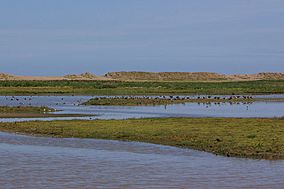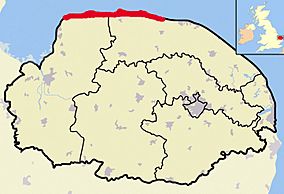Nature reserves in the North Norfolk Coast Site of Special Scientific Interest facts for kids
Quick facts for kids North Norfolk Coast SSSI |
|
|---|---|

|
|

North Norfolk Coast SSSI shown within Norfolk in red
|
|
| Location | Norfolk, East of England, England |
| Established | 1986 |
The North Norfolk Coast Site of Special Scientific Interest (SSSI) is a very important protected area in Norfolk, England. It's a long, thin stretch of coastline. This special area starts near Old Hunstanton and goes east for about 43 kilometers (27 miles) to Kelling. It covers a huge area of 7,700 hectares (19,027 acres).
This coast is protected in many ways. It is part of the Natura 2000 network, a Special Protection Area (SPA), and a Ramsar site. These names mean it's recognized as important for nature around the world. It's also part of the Norfolk Coast Area of Outstanding Natural Beauty (AONB). Places like Scolt Head Island and the coast from Holkham National Nature Reserve to Salthouse are even a Biosphere Reserve.
The North Norfolk Coast SSSI has many different natural places, called habitats. These include sandy beaches, shingle (small stones), salt marshes, and reed beds. It's super important for birds that nest here and for the huge numbers of wildfowl (like ducks and geese) that spend winter here. Many parts of the SSSI are now nature reserves. These reserves also protect rare insects and plants.
Contents
Discovering the North Norfolk Coast SSSI
The North Norfolk Coast SSSI was created in 1986. It brought together many smaller protected areas that already existed. This area has a wide range of habitats. The parts of the coast that are covered by water at high tide and exposed at low tide are called the intertidal zone. Here, you'll find bare mud, sand, and shingle. Some areas have algae or eelgrass, which ducks and geese love to eat in winter.
Salt Marshes and Sand Dunes
Salt marshes grow in calm parts of the coast, often behind islands or sand spits. The SSSI says these salt marshes are "among the best in Europe." They have many different kinds of plants. Sand dunes are found in several spots along the coast. The best examples are at Holme Dunes, Holkham, Blakeney Point, and Scolt Head Island. Blakeney Point and Scolt Head Island are also important for studying how landforms change over time.
Reed Beds and Grasslands
Reed beds are areas with tall grass-like plants called reeds. You can find large reed beds at Titchwell Marsh, Brancaster, and Cley Marshes. There are also grasslands, which are fields where animals like cows graze. These areas were once salt marshes. At Holkham, there's a small area of Corsican pine trees. These trees help other plants and shrubs grow by providing shelter.
Wildlife: Birds, Animals, and Plants
The SSSI is a Special Protection Area because its many habitats are important for birds all year round.
- Breeding Birds: Many Sandwich terns and little terns nest here, especially at Blakeney and Scolt Head Island. These colonies are important for all of Europe. The coast is also nationally important for common terns, pied avocets, and birds that live in reed beds. These include western marsh harriers, Eurasian bitterns, and bearded reedlings.
- Wintering Birds: Huge numbers of ducks and geese spend their winters here.
- Other Animals: The SSSI is home to the endangered water vole and the rare natterjack toad. You might also find the starlet sea anemone.
- Rare Plants: Special plants like lesser centaury, sea barley, and bee orchid grow here.
Protecting the Coast
Because this area is so important for wildlife, much of it has been turned into nature reserves. The first reserve was Blakeney Point, bought by Charles Rothschild in 1912. He gave it to the National Trust, which still looks after it. Many visitors come to the North Norfolk Coast to enjoy nature. A survey in 2005 found that 39% of visitors came mainly for birdwatching. Popular places like Titchwell Marsh (run by the Royal Society for the Protection of Birds), Cley Marshes (run by the Norfolk Wildlife Trust), and Holkham National Nature Reserve each get over 100,000 visitors every year.
Nature Reserves of the North Norfolk Coast SSSI
In 2012, there were ten nature reserves within the SSSI. Together, they covered 6,016 hectares (14,863 acres). This is about 78% of the entire SSSI! These reserves are actively managed to protect nature and often have facilities for visitors. Different groups own and manage these reserves. This is because land became available at different times, and each group has its own goals for conservation.
| Reserve name | Management | Area | Date | Remarks | Grid ref. |
|---|---|---|---|---|---|
| Blakeney Point | National Trust | 1,097 ha (2,710 acres) | 1912 | A national nature reserve. It's a 3-mile-long sand and shingle spit that the sea is slowly moving inland. | |
| Cley Marshes | Norfolk Wildlife Trust | 176 ha (435 acres) | 1926 | Has a visitor centre and bird hides. Part of the reserve is owned by the National Trust. In 2012, the NWT raised money to buy more land next to the reserve. | |
| Holkham National Nature Reserve | Natural England and the Holkham Estate | 3,531 ha (8,725 acres) | 1967 | Owned by the Earl of Leicester's Holkham Estate and the Crown Estate. It has beaches, sand dunes, salt marsh, pine trees, and grazing fields. There are two bird hides. | |
| Holme Bird Observatory | Norfolk Ornithological Association | 5 ha (13 acres) | 1962 | A place for bird ringing to study bird migration. It has scrubby dunes and pine trees. | |
| Holme Dunes | Norfolk Wildlife Trust | 213 ha (526 acres) | 1965 | Also a national nature reserve. It has sand dunes, grazing marsh, salt marsh, and freshwater pools. The coast helps keep these natural places healthy. | |
| Kelling Quags | Norfolk Ornithological Association | 5.7 ha (14 acres) | 1984 | Has pools and wet grazing meadows behind a shingle ridge. | |
| Salthouse Marshes | Norfolk Wildlife Trust | 66 ha (163 acres) | 1971 | Has pools and wet grazing meadows behind a shingle ridge. | |
| Scolt Head Island | Natural England | 737 ha (1,821 acres) | 1968 | Owned by the National Trust and Norfolk Wildlife Trust. It's an island with sand dunes, salt marsh, shingle, and mud flats. It's mostly left to nature. | |
| Stiffkey Fen | Buxton Conservation Trust | 14 ha (35 acres) | 1999 | Has a reed bed and a freshwater lagoon with islands. It was given to the Trust by Lord Buxton. | |
| Titchwell Marsh | Royal Society for the Protection of Birds | 171 ha (420 acres) | 1973 | Has a reed bed, freshwater lagoon, tidal lagoon, and dunes. It has a visitor centre and bird hides. |

